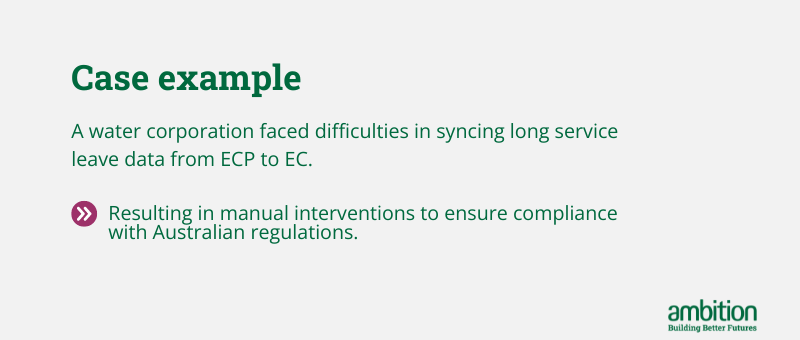Please beware of recruitment scams that are currently targeting jobseekers. Click here for further advice.

The top 3 integration challenges with Employee Central and Employee Central Payroll systems
Amidst the benefits that SAP Employee Central and Employee Central Payroll (ECP) offer, integration challenges have emerged as a significant concern for many of my client base. Here are three of the key issues they have encountered:
1. Data synchronisation
Latency issues. In high transactional environments such as healthcare or utilities sectors, delays in data processing can produce incorrect information around payroll, and annual/personal/long service leave calculations.
Error handling. here is always the possibility of human error when it comes to data input into a large system such as SuccessFactors. This can lead to inaccuracies in data synchronisation between Employee Central and Employee Central Payroll.
Case example - A water corporation faced difficulties in syncing long service leave data from ECP to EC. This resulted in manual interventions to ensure compliance with Australian regulations.

2. The complexity of pay rules and configurations
Global payroll complexity. Australia ranks among the top third globally in terms of payroll complexity. Translating pay rules from EC into ECP requires a deep technical understanding of both systems. Unfortunately, this deep expertise isn’t all that common in the Australian market yet, resulting in a reliance on consulting firms or implementation partners for specialised knowledge, which is not cost-effective.
Long-term outlook. With time, the availability of skilled professionals is expected to improve, potentially alleviating some of the integration hurdles associated with complex pay rules.
3. Customisation and flexibility
API integration framework. Custom fields in Employee Central and their counterparts in Employee Central Payroll don’t always align. This can cause all sorts of integration issues. This really comes down to how the API integration frameworks have been built.
Architectural considerations. Well-architected API frameworks facilitate smoother data flow between systems, reducing the likelihood of integration issues.
Importance of initial setup. Investing in robust API architecture during the initial setup phase can mitigate future challenges related to customisation and flexibility.
Mastering integration
While SuccessFactors Employee Central and Employee Central Payroll offer powerful solutions for HR and payroll management, successful implementation hinges on addressing integration challenges effectively. By prioritising data synchronisation, fostering expertise in payroll complexities, and investing in robust API integration frameworks, organisations can navigate these challenges and unlock the full potential of their HRIS investment.
If you are looking for a market overview or need any assistance in your job search reach out to me here or our expert team of consultants here.
Watch our Hot tips & insights video series for further insight, just head to our video library.
Author Owen Marquis has been recruiting in Business Transformation and Technology in Melbourne since 2018.
Edited by Melanie Brown, Marketing Executive, Ambition Group Australia.






